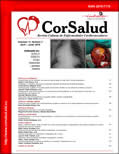Protección renal y hepática por condicionamiento isquémico a distancia en la revascularización miocárdica quirúrgica
Resumen
Introducción: Breves períodos de isquemia a distancia pueden limitar el daño miocárdico producido por la isquemia/reperfusión.
Objetivo: Identificar el efecto del condicionamiento isquémico a distancia con fines de protección renal y hepática, relacionado al comportamiento postoperatorio de los niveles de creatinina y transaminasas glutámico-purúvica y glutámico-oxalacética en la revascularización miocárdica quirúrgica.
Método: Se realizó un estudio cuasiexperimental, explicativo, comparativo con control histórico, en dos grupos de 247 pacientes cada uno, propuestos para revascularización miocárdica quirúrgica. Se colocó un torniquete en el brazo derecho, en el grupo estudio, alternando 3 insuflaciones (con una presión de 200 mmHg) con 3 desinsuflaciones, durante cinco minutos cada una. Este procedimiento se realizó previo, durante y después de la mayor isquemia inducida, provocada por el pinzamiento de la arteria coronaria.
Resultados: Se logró una disminución significativa en los valores de creatinina (p< 0,001), transaminasa glutámico-purúvica (p<0,001) y transaminasa glutámico-oxala-cética (p<0,05).
Conclusiones: El condicionamiento isquémico a distancia es una importante herramienta a tener en cuenta para la protección renal y hepática en la revascularización miocárdica quirúrgica.Descargas
Citas
1. Llapur Milián R, González Sánchez R. La enfermedad cardiovascular aterosclerótica desde la niñez a la adultez. Rev Cubana Pediatr [Internet]. 2017 [citado 26 Dic 2018];89(3):271-7. Disponible en: http://www.revpediatria.sld.cu/index.php/ped/article/view/389/130
2. Carrasco Chinchilla F. Postcondicionamiento isquémico a distancia en la angioplastia coronaria [Tesis]. España: Universidad de Málaga [Internet]; 2014 [citado 10 Ene 2019]. Disponible en: https://riuma.uma.es/xmlui/handle/10630/7873
3. Ministerio de Salud Pública. Anuario Estadístico de Salud 2017. La Habana: Dirección Nacional de Registros Médicos y Estadísticas de Salud; 2018.
4. Mitchell RN, Kumar V, Abbas AK, Aster JC. Compendio de Robbins y Cotran. Patología estructural y funcional. 9ª ed. Barcelona: Elsevier; 2017.
5. Balakumar P, Sharma NK. Healing the diabetic heart: does myocardial preconditioning work? Cell Signal. 2012;24(1):53-9.
6. Hensley FA, Martin DE, Gravlee GP. Anestesia cardíaca. 1ª ed. Madrid: Marbán; 2004.
7. Murry CE, Jennings RB, Reimer KA. Preconditioning with ischemia: a delay of lethal cell injury in ischemic myocardium. Circulation. 1986;74(5):1124-36.
8. Przyklenk K, Bauer B, Ovize M, Kloner RA, Whittaker P. Regional ischemic 'preconditioning' protects remote virgin myocardium from subsequent sustained coronary occlusion. Circulation. 1993;87(3):893-9.
9. Jankauskas SS, Pevzner IB, Andrianova NV, Zorova LD, Popkov VA, Silachev DN, et al. The age-associated loss of ischemic preconditioning in the kidney is accompanied by mitochondrial dysfunction, increased protein acetylation and decreased autophagy. Sci Rep [Internet]. 2017 [citado 12 Ene 2019];7:44430. Disponible en: https://www.nature.com/articles/srep44430
10. Veighey K, Macallister RJ. Clinical applications of remote ischemic preconditioning. Cardiol Res Pract [Internet]. 2012 [citado 12 Ene 2019];2012:620681. Disponible en: http://downloads.hindawi.com/journals/crp/2012/620681.pdf
11. Candilio L, Hausenloy D. Is there a role for ischaemic conditioning in cardiac surgery? F1000Research [Internet]. 2017 [citado 14 Ene 2019];6:563. Disponible en: https://doi.org/10.12688/f1000research.10963.1
12. Zhou C, Bulluck H, Fang N, Li L, Hausenloy DJ. Age and surgical complexity impact on renoprotection by remote ischemic preconditioning during adult cardiac surgery: a meta-analysis. Sci Rep [Internet]. 2017 [citado 14 Ene 2019];7:215. Disponible en: https://www.nature.com/articles/s41598-017-00308-3.pdf
13. Zhou CC, Ge YZ, Yao WT, Wu R, Xin H, Lu TZ, et al. Limited clinical utility of remote ischemic conditioning in renal transplantation: a meta-analysis of randomized controlled trials. PLoS One [Internet]. 2017 [citado 14 Ene 2019];12(1):e0170729. Disponible en: http://journals.plos.org/plosone/article?id=10.1371/journal.pone.0170729
14. Alreja G, Bugano D, Lotfi A. Effect of remote ischemic preconditioning on myocardial and renal injury: meta-analysis of randomized controlled trials. J Invasive Cardiol. 2012;24(2):42-8.
15. Zhang M, Yang D, Gong X, Ge P, Dai J, Lin L, et al. Protective benefits of AMP-activated protein kinase in hepatic ischemia-reperfusion injury. Am J Transl Res [Internet]. 2017 [citado 14 Ene 2019];9(3):823-9. Disponible en: http://www.ajtr.org/files/ajtr0045806.pdf
16. Walsh SR, Boyle JR, Tang TY, Sadat U, Cooper DG, Lapsley M, Norden AG, et al. Remote ischemic preconditioning for renal and cardiac protection during endovascular aneurysm repair: a randomized controlled trial. J Endovasc Ther. 2009;16(6):680-9.
17. Walsh SR, Sadat U, Boyle JR, Tang TY, Lapsley M, Norden AG, et al. Remote ischemic preconditioning for renal protection during elective open infrarenal abdominal aortic aneurysm repair: randomized controlled trial. Vasc Endovascular Surg. 2010;44(5):334-40.
18. Pedersen KR, Ravn HB, Povlsen JV, Schmidt MR, Erlandsen EJ, Hjortdal VE. Failure of remote ischemic preconditioning to reduce the risk of postoperative acute kidney injury in children undergoing operation for complex congenital heart disease: a randomized single-center study. J Thorac Cardiovasc Surg. 2012;143(3):576-83.
19. Kunst G. From coronary steal to myocardial, renal, and cerebral protection: more questions than answers in anaesthetic preconditioning? Br J Anaesth. 2014;112(6):958-60.
20. Walsh SR, Nouraei SA, Tang TY, Sadat U, Carpenter RH, Gaunt ME. Remote ischemic preconditioning for cerebral and cardiac protection during carotid endarterectomy: results from a pilot randomized clinical trial. Vasc Endovascular Surg. 2010;44(6):434-9.
21. Oh CS, Kim SH, Lee J, Rhee KY. Impact of remote ischaemic preconditioning on cerebral oxygenation during total knee arthroplasty. Int J Med Sci [Internet]. 2017 [citado 16 Ene 2019];14(2):115-22. Disponible en: http://www.medsci.org/v14p0115.pdf
22. Zimmerman RF, Ezeanuna PU, Kane JC, Cleland CD, Kempananjappa TJ, Lucas FL, et al. Ischemic preconditioning at a remote site prevents acute kidney injury in patients following cardiac surgery. Kidney Int. 2011;80(8):861-7.
Descargas
Publicado
Cómo citar
Número
Sección
Licencia
Aquellos autores/as que tengan publicaciones con esta revista, aceptan los términos siguientes:- Los autores/as conservarán sus derechos de autor y garantizarán a la revista el derecho de primera publicación de su obra, el cuál estará simultáneamente sujeto a la Licencia de reconocimiento de Creative Commons que permite a terceros compartir la obra siempre que se indique su autor y su primera publicación esta revista.
- Los autores/as podrán adoptar otros acuerdos de licencia no exclusiva de distribución de la versión de la obra publicada (p. ej.: depositarla en un archivo telemático institucional o publicarla en un volumen monográfico) siempre que se indique la publicación inicial en esta revista.










